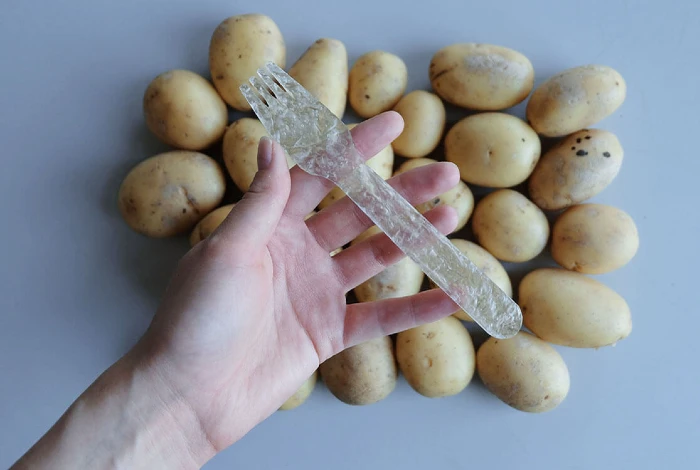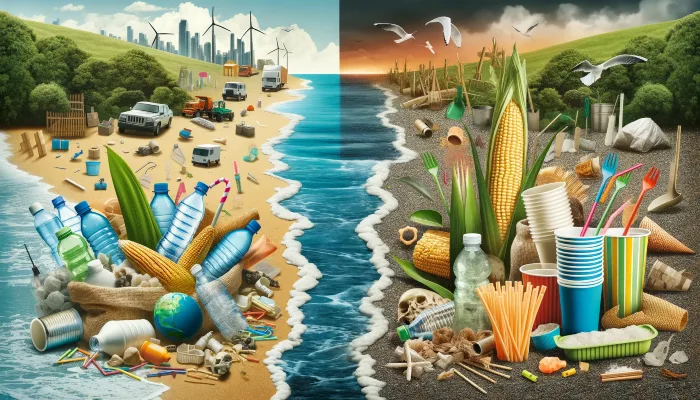In a world grappling with the repercussions of plastic pollution, Australia’s recent bans on plastic straws, crockery, polystyrene containers, and lightweight single-use plastic bags stand as a testament to its commitment to environmental conservation. This initiative, sweeping across Victoria, South Australia, Western Australia, New South Wales, and the ACT, marks a decisive step in curbing the plastic menace that threatens our oceans and ecosystems.
The Complications That Are Bioplastics
With such stringent measures against conventional plastics, one might ponder: why not pivot to bioplastics? Aren’t these plant-based alternatives the panacea for our plastic woes? Surprisingly, the reality isn’t as straightforward as it seems. While enticing in theory, bioplastics currently don’t live up to their promise. Despite studies suggesting that up to 85% of fossil-fuel based plastics could be replaced with bioplastics, the practicalities tell a different story, especially in Australia.
The key issue? Australia lacks the infrastructure to compost or process bioplastics effectively at the end of their lifecycle. This bottleneck leads to a counterintuitive outcome: bioplastics, despite their green allure, end up in landfills, just like their fossil-fuel based counterparts. As a result, many states in Australia are now including bioplastics in their plastics bans, underscoring a preference for avoiding single-use plastics altogether.
A Closer Look at Bioplastics
The term ‘bioplastics’ is an umbrella term that encompasses a variety of materials. It’s essential to demystify this term to understand the complexities involved. There are three key categories within this realm:
- Bio-Based Plastics: These are made from biological raw materials such as corn, sugarcane, cellulose, and algae. They’re an alternative to oil-based polymers, but don’t necessarily biodegrade.
- Biodegradable Plastics: These can be broken down by microorganisms into natural elements. However, the term ‘biodegradable’ doesn’t specify the duration or conditions required for this process, leading to misconceptions about their environmental impact.
- Compostable Plastics: A subset of biodegradable plastics, these are designed to biodegrade within a known timeframe under composting conditions. In Australia, they can be certified for commercial or home composting.
The distinction is crucial. The label ‘bioplastic’ doesn’t guarantee that a product is plant-based or that it will break down quickly in the environment. In some cases, even biodegradable plastics are derived from fossil fuels.

The Path Forward
As we navigate this complex landscape, the conversation shifts from finding a direct substitute for plastics to rethinking our consumption patterns. The challenge lies in developing sustainable practices that transcend mere material substitution. It’s about embracing a holistic approach that combines reducing single-use plastics, enhancing recycling systems, and investing in truly sustainable alternatives.
In the quest for a greener future, bioplastics, in their current state, may not be the silver bullet we hoped for. But they open a critical dialogue about sustainability and innovation, paving the way for more effective solutions in our fight against plastic pollution.
Beyond The Green Gloss That Are Often Bioplastics
As Australia, and indeed the world, shifts its focus towards more sustainable practices, bioplastics have emerged as a potential eco-friendly alternative to traditional plastics. But are they truly a greener choice? To answer this, we need to delve into the complete lifecycle of these materials – from production to disposal.
Manufacturing: A Double-Edged Sword
At first glance, the manufacturing process of bio-based plastics seems to offer a sigh of relief for the environment. Generally, they result in lower greenhouse gas emissions compared to their fossil fuel-based counterparts. However, this isn’t a universal truth. The production of plastics from plant sources brings its own set of environmental impacts, including the use of land, water, and agricultural chemicals. There’s an underlying threat here: increased demand for agricultural land could lead to biodiversity loss and potentially compete with food production. It’s a delicate balance between two pressing needs.
The Widespread Misconception in Usage
Bioplastics often replace familiar single-use items like plastic bags, takeaway coffee cups, and cutlery. In Australia, around 90% of the bioplastics sold are certified compostable. However, in most cases, a reusable alternative would trump these in terms of sustainability. It’s a classic case of old habits dying hard, as we replace one disposable item with another, albeit marginally greener.
Yet, it’s not all doom and gloom. Some uses of bioplastics, such as compostable bags for kitchen food waste caddies, have shown to enhance the collection of food waste. This leads to less food waste in landfills and, consequently, fewer greenhouse gas emissions – a small but significant victory in our environmental struggle.

When it comes to the pivotal issue of plastic waste and pollution, bioplastics can be just as harmful as conventional plastics if they end up in the environment. The image of a turtle choking on a bioplastic bag is as distressing and real as choking on a conventional plastic bag.
Biodegradable plastics, misleading by name, can still take years, even decades, to break down in nature.
Design Dilemmas
The ideal scenario for bioplastics is to be designed for either recycling or composting. However, some bioplastics fall through the cracks, being neither. This poses significant challenges for waste management systems, leading to contamination of recycling or compost streams. Their final destination, sadly, is often the landfill.
Greenwashing and the Need for Regulation
Recent research conducted for WWF Australia has uncovered a troubling trend of greenwashing in the bioplastics industry. Terms like “earth friendly” and “plastic-free” contribute to consumer confusion. The need for regulating the industry and standardizing terminology is more crucial than ever. It would provide clarity and aid consumers in making informed choices, steering clear of misleading labels.
Wrapping Up the Bioplastic Debate
As we scrutinize the role of bioplastics in our journey towards sustainability, it’s clear that the path isn’t as straightforward as swapping one material for another. It’s a complex puzzle of environmental, economic, and societal factors. The solution lies not just in adopting alternative materials, but in fundamentally changing our approach to consumption and waste. The conversation around bioplastics is far from over, but it’s a vital one in our quest for a sustainable future.
Compostable? Bioplastics and the Promises Made
Compostable plastics, hailed as a beacon of hope in our battle against plastic waste, carry a promise that’s proving hard to fulfill. Designed to break down in compost—either at home or commercially—the reality of their disposal is a stark contrast to their green aspirations.
The Australian Context: A Patchwork of Policies We Can Learn From
In Australia, the journey of compostable plastics from bin to compost is fraught with inconsistencies and limitations. While South Australian Standard compostable plastics find their way into food organics and garden organics bins, and some councils in Hobart follow suit, the rest of the country presents a different picture. Many other states and councils accept food and green waste but draw the line at compostable plastics, except for specific council-supplied food waste caddy liners.

This fragmented approach leads to a disheartening outcome: the majority of compostable plastics used in Australia end up in landfills. There, instead of harmlessly integrating back into the earth, they emit methane—a potent greenhouse gas. And often, this methane isn’t captured, adding to environmental woes.
The PET Reality
This situation begs the question: if these bioplastics end up in landfills, emitting harmful gases, where’s the benefit? Especially when they replace materials like PET used in soft drink bottles, which are readily recyclable, the environmental calculus becomes even more complex. It’s a classic case of good intentions potentially causing unintended harm.
Bioplastics: When Do They Make Sense?
In the face of these revelations, what’s the sensible approach to using bioplastics in Australia? The answer is nuanced. If you’re using compostable bin caddies that can be composted at home, or if your county (known as council in Australia) accepts them, then yes, it makes sense. It’s a small but meaningful step towards sustainability.
However, for most other applications, avoiding plastics altogether is the wiser choice. Your reusable coffee cup and shopping bags aren’t just accessories; they’re powerful tools in the fight against plastic pollution.
More To Discover
- Saving the Northern Spotted Owl May Require Killing Barred Owls
- Tiny Nuclear Battery Promises 50-Year Phone Charge, Breaking Radioactive Ground
- The Groundbreaking Shutdown of the Original Nuclear Reactor Will Unlock More Future Fusion Insights
- Oil and Corn Giants Unite in Unlikely, And Unnecessary, Alliance Against Electric Cars
The journey towards a sustainable future with bioplastics isn’t straightforward. It requires not just the development of these materials but also the establishment of viable pathways for their recycling and composting.
Until these systems are in place, the most sustainable choice might be the simplest one: reduce, reuse, and, where possible, refuse single-use plastics, bioplastic or otherwise. It’s a challenge that calls for a collective effort and a shift in our daily habits—a challenge we must embrace for the sake of our planet.



















